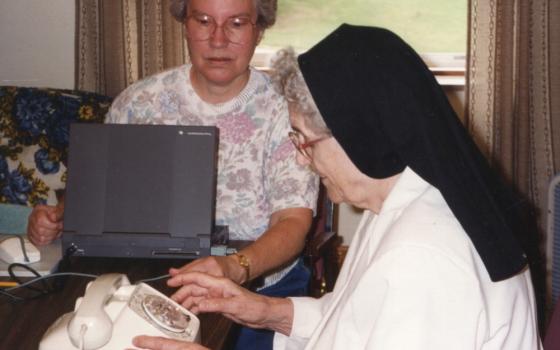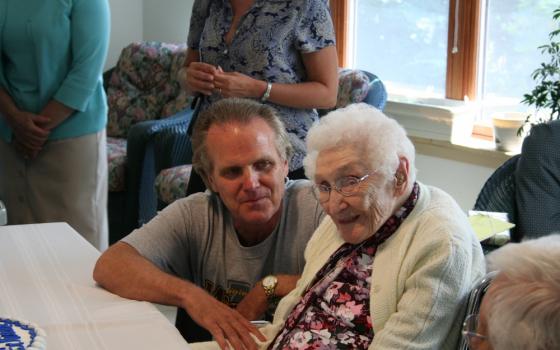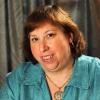From the time she was a little girl, Sr. Gabriel Mary Spaeth wanted to be a nun. She grew up on a farm about 30 miles north of Milwaukee and attended a school run by the School Sisters of Notre Dame. “I admired their personalities and their kindness,” she said. “You’d see the fun they had between themselves. Their whole-hearted goodness made me want to be like them. And I wanted to be a teacher.”
She entered the School Sisters’ convent in Milwaukee in 1947 at age 15 and professed vows in 1953. Spaeth finished high school, graduated from Mount Mary College and then earned a master’s degree in education and administration at the University of Wisconsin at Madison. During her 68 years as a School Sister, she taught nearly every grade level and worked as a school administrator. During a four-year term with the community’s leadership team, she worked on health care issues.
That’s when she met David Snowdon, an epidemiologist at the University of Minnesota who was researching aging. Their connection launched a long-term relationship between the School Sisters and medical researchers that continues today and ensures that the women would continue their educational mission for decades, even long after they die.
When Snowdon asked the sisters in 1986 to participate in a study about Alzheimer’s disease, Spaeth thought the project sounded worthwhile. “I’d seen people with dementia and how they just weren’t themselves,” Spaeth, 83, said in a telephone interview from a convent near Milwaukee. “The deteriorating effects that Alzheimer’s has on their whole character and social life were awful. I thought if we could do anything to help, we should.”
Alzheimer’s is an irreversible, progressive brain disorder that slowly destroys memory and thinking skills. It is the most common cause of dementia among older adults. About 5.3 million U.S. Americans have Alzheimer’s.
For more than 16 years, Spaeth traveled the country, visiting convents in her order’s seven American provinces. She visited sisters, age 75 or older, about once every 18 months. She would ask the sisters: “Where are you? What’s today’s date? Who’s the president?” She would ask the women to identify an image on a card and test them on how many words they could recall from a list. She would also record how long it took the sisters to walk a certain distance and observe how well they completed simple tasks.
“I always would be very encouraging when I realized they were frustrated,” Spaeth recalled. “Sometimes it was someone who got very excitable, and I would hold their hand. Our big thing was to keep them at ease. This whole study – it was the personal touch that made a difference.”
Spaeth and another School Sister administered hundreds of assessments, carefully recording and transcribing the results of tests on 678 sisters. The data they carefully collected became the basis of the Nun Study, which led to groundbreaking research on aging and Alzheimer’s disease. Snowdon’s 2001 book, Aging with Grace, was based on that research and drew immense attention to Alzheimer’s disease.
The painstaking records Spaeth collected remain available for researchers to compare with new findings. Snowdon’s project, largely funded by the National Institute on Aging, moved to University of Kentucky Sanders-Brown Center on Aging in the early 1990s, when Snowdon began working there. After Snowdon retired, it returned in 2009 to the University of Minnesota, where researchers undertook two more rounds of assessments.
Snowdon’s work drew attention in the medical world, with publications in The Journal of the American Medical Association and The Journal of Gerontology. His research also appeared in the popular press, with segments about him and some of the sisters appearing in outlets including The New York Times and USA Today, and on the Today Show and National Public Radio.
“Aging is not the cause of health problems in old age,” Snowdon wrote in 2001. “Disease is the culprit.”
The School Sisters’ commitment to education made them ideal for Snowdon’s research. The congregation dates to 1833, when Caroline Gerhardinger started a religious community in Bavaria dedicated to Christian education for girls. In 1847, several sisters moved to Pennsylvania to run a school for German immigrants. By 1850, the sisters staffed six schools in America.
In the late 1980s, the School Sisters of Notre Dame numbered more than 7,000 in 30 countries, with 4,000 sisters in North America. Like most women’s religious communities in the United States, its numbers have declined significantly. Today, the School Sisters have about 2,800 sisters worldwide, 1,600 of them in two North American provinces.
Today, sisters work in early childhood education, special education, middle school and secondary education. The congregation also sponsors two colleges, Mount Mary University in Milwaukee and Notre Dame of Maryland University in Baltimore.
“You educate in many forms,” said School Sr. Charlene Zeisset, a medical doctor who serves as liaison to the Nun Study. Now 64, she was in medical school when Snowdon began the project. “We may be working for social justice or creation justice, but everyone brings to it that bent of educating,” she said. “Participating in this was another way to continue to minister as educators even when they could no longer teach.”
The community offered a unique control group for a longitudinal study. The women came from similar backgrounds, and most were highly educated. They ate the same food, shared living spaces, received similar health care, and their routines were likely to remain stable.
Medical researchers had studied religious communities before. Snowdon had earlier worked on a study of the Lutheran Brotherhood that looked at the connection between cancer and heart disease with alcohol use. He had also participated in a study investigating the impact of diet on the health of Seventh-day Adventists. A 1950s study of nuns found a link between breast cancer and hormones. The Religious Orders Study, started in 1993, also investigates the aging brain.
The Nun Study is unique in the researchers’ access to the study participants’ early writings, which led to theories about how education, complex language abilities and positive outlooks might affect cognitive function as people age, according to a summary provided by the Nun Study researchers at the University of Minnesota. It’s also unique in its size of samples, considered one of the largest pools of brain donations in the world.
Snowdon again highlighted the School Sisters’ commitment to education when, a few year’s into the study in late 1990, he asked the sisters to donate their brain tissue after they died. He had expected resistance. “The brain is not like other organs,” he quoted a colleague as saying. “People think of it as who they are – it contains their identity. It’s loaded with meaning – personal, emotional, spiritual.”
Church teaching offered no obstacle. “Autopsies can be morally permitted for legal inquests or scientific research,” according to the Catechism of the Catholic Church. “The free gift of organs after death is legitimate and can be meritorious.”
Some sisters declined. But most were enthusiastic about contributing to research. “I didn’t really know what it was going to be about, but I thought if science could learn something from this program, then I was glad to be a part of it,” one sister, then 93, told TIME magazine in 2001.
“As sisters, we made the hard choice not to have children,” another sister says in Snowdon’s book. “Through brain donation, we can help unravel the mysteries of Alzheimer’s disease and give the gift of life in a new way to future generations.”
One sister Snowdon quoted put it this way: “Our congregation was founded to work with the poor and the powerless. Who’s more powerless than someone with Alzheimer’s disease?”
With the brain donations, he and his colleagues compared data about the women’s cognitive and physical functioning with their brains’ pathology, drawing conclusions about how people decline as they age and who might be likely to develop the symptoms of Alzheimer’s.
Early findings suggested that people with strong language skills at a young age were less likely to develop dementia, and that people with positive outlooks lived longer. The Nun Study was one of the first to demonstrate that individuals differ in how much brain pathology must be present to produce clinical symptoms of disease in life, according to a summary of a National Institute on Aging report. The research also showed that small strokes predict the correlation between symptoms and Alzheimer’s disease brain pathology.
Of the 678 sisters originally enrolled in the study, 600 died and were autopsied. Only about 50 withdrew from the study, a participation rate researchers say is exceptionally high. Researchers continue to monitor eight surviving sisters, who are all over 100 years old.
Researchers at the University of Minnesota have transferred audiotapes and VHS tapes to digital formats and scanned slide samples to preserve them and make them easier to share with other researchers. Current research includes analyzing the existing data in new ways. Researchers are collaborating with the Honolulu-Asia Aging Study, which studies cognitive decline and dementia in Japanese-American men living in Hawaii.
“Both of these studies have been criticized as too narrow,” said Laura Hemmy, assistant director of the Nun Study. “We are looking at the pathology in both studies. If they’re the same, it suggests we’re seeing something that applies to all people.”
The university is also preparing a second School Sisters study. The new study will have no age limits and will not require autopsy. It will study mid- to early-life risk factors for cognitive changes, Hemmy said.
“We’re interested in personality and healthy habits like diet and walking,” she said. “There are questions about religion and spirituality.”
Spaeth and Zeisset plan to participate in the new study. In the meantime, Spaeth and other sisters have joined the Religious Orders Study. Researchers will likely compare relevant data from both studies.
“There’s a lot that can still be studied for years,” Zeisset said.
More than 30 years after Snowdon began the Nun Study, concern over Alzheimer’s is high; one poll found that people over 50 are more worried about developing Alzheimer’s than cancer. Alzheimer's disease is the sixth-leading cause of death in the United States, according to the Alzheimer’s Association. It is the only cause of death among the top 10 in the United States that cannot be prevented, cured or slowed. By 2030, 72 million baby boomers will reach the age that puts them at greater risk of Alzheimer’s.
“Thinking about losing yourself is very frightening,” said Dean M. Hartley, director of Science Initiatives, Medical and Scientific Relations for the Alzheimer’s Association
At the time of Snowdon’s early work, “People didn’t think a lot about lifestyle as something that would affect the development of the disease,” Hartley said. “Where his work was groundbreaking is where we are today in understanding how lifestyle might fit in slowing or preventing the disease.”
Further research seems to support Snowdon’s findings that people with higher levels of education may have a lower risk of developing symptoms, he said. Snowdon’s early work on positive thinking has led to research on the role of loneliness and isolation, he added.
Researchers continue to work on the connection between strokes and Alzheimer’s, Hartley said. That’s where the sisters’ brain donations became so valuable, he said.
About 50 sisters remained in the study when Hemmy got involved. She worked on the later assessments and called the sisters “smart and snappy.”
The sisters are so invested in cooperating, that some want to practice the exercises between assessments, Hemmy said. “It’s no accident they all want to do so well,” she said. “They’re all so educated. They want to try their hardest.”
She said working with the sisters was fun. “They’ve been doing the study for a long time and take a lot of ownership in it,” she said. “Most of them seem to like the idea and they’re very supportive of the older sisters in the study.”
She’s learned from them, Hemmy said. “I like that I can think of them as having a social organization and a leadership structure,” she said. “I can learn about their culture and learn from them.”
Another lesson comes from the sisters’ participation, Hemmy said. “Research is not appealing to a lot of people,” she said. “They fear it won’t go the way they want it to. Or the researchers might not communicate with them. Those are very real fears.”
Spaeth describes her work with the study as the highlight of her career. Her role has taught her to stay active. “A lot of the sisters started doing exercise and other things to keep themselves happy,” she said. “We’re still educating others to have better health.”
Religious communities provide valuable lessons, Zeisset said. “How we care for our aging sisters could be an example of how you respect the wisdom that these older sisters have,” she said. “How can we as a country respect those with age and wisdom?”
In Aging with Grace, Snowdon described the broad lesson of the project. The sisters “have shown me that old age is not something to fear and revile,” he said. “It can be a time of promise and renewal, of watching with a knowing eye, of accepting the lessons that life has taught and, if possible, passing them on to the generations that follow.”
[Renée K. Gadoua is a freelance writer and editor in Syracuse, N.Y. Follow her on Twitter @ReneeKGadoua.]
Editor's Note: An earlier version of this article contained a misspelling of David Snowdon's name.





